For at least the last century, literacy for Mexican males has been significantly higher than that for females. According to the 2010 census 93.7% of Mexican males aged 15 and over were literate compared to only 91.1% of females. Males have higher literacy levels in all 32 Mexican states except for Sinaloa (males – 94.1%, […]
Why did CONAPO underestimate Mexico’s population by almost two million people? Mexico’s changing population dynamics
Making population projections is risky business. Birth and death rate trends can change unexpectedly. Perhaps more difficult to forecast accurately, in Mexico’s case, are international migration rates. The most recent official population projection available from the Mexican Government’s CONAPO (Spanish acronym for National Population Commission) website estimates that the Mexican population will peak at 130.3 […]
More problems for residents of Valle de Chalco on the south-eastern edge of Mexico City
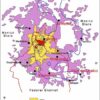
More than 200 homes in the low-income settlement of Valle de Chalco on the south-eastern edge of Mexico City, in the State of México, were flooded by raw sewage last month. The affected homes were in San Isidro and La Providencia, in Valle de Chalco (see map). Locations in Valley of Mexico with high incidence […]
Access to services is worst in the smallest rural localities of Mexico
Access to services such as schools, public transport or the internet are better in cities than in rural areas (localities in Mexico with fewer than 2,500 inhabitants). However some rural areas have far better access than others. Perhaps not surprisingly, the number of inhabitants of a rural locality is directly related to its access to […]
Fertility decline not as fast as expected, but faster in some areas of Mexico than others
Data from the 2010 census indicate that the fertility rate did not decline as fast in the last decade as previously expected. On the other hand, the actual reduction was significant and consistent with Mexico’s demographic transition which will lead it to zero natural population growth by mid-century. See our 15 May 2010 post: Mexico’s […]
The on-going transformation of Mexico City

A feature article in thestar.com (link below) summarizes some of the reasons behind our long-held view that Mexico City has started, and is still undergoing, a noteworthy transformation. Change is happening not only in the urban fabric but in many aspects of the daily lives of “capitalinos“, the most polite of the various terms used […]
Our top 10 list of “googled” phrases which led to Geo-Mexico.com
Our trusty server stats include these “top ten” search phrases. Each of them (when entered into a certain famous leading search engine) magically brought one or more viewers to Geo-Mexico.com: 10- parangaricutiro tongue twister – our post Geographic tongue-twister relating to a volcano explains this tricky-to-pronounce search 9- what kind of aztec indian would you […]
The Battle of Puebla is re-enacted each year on Cinco de Mayo (May 5), but in Mexico City

The Mexican holiday of Cinco de Mayo (5 May) commemorates the Battle of Puebla, fought on May 5, 1862. Puebla is a major city about 100km east of Mexico City, on the historically important route to the port of Veracruz. In 2012, to mark the 150th Anniversary of the Battle of Puebla, a major re-enactment […]
Mexico’s population keeps growing, but at a slower pace
The 2010 census indicates that since 1960 Mexico’s population has more than tripled to 112.3 million. However, the growth rate between 2000 and 2010 (1.4% per year) is less than half the 3.4% rate of increase experienced in the 1960s. If Mexico’s population had continued to grow at 3.4% since 1960, it would have been […]
Somewhat surprisingly, the number of Mexicans speaking indigenous languages has increased significantly in the past 20 years. In 2010 there were 6.7 million indigenous speakers over age five compared to 6.0 million in 2000 and 5.3 million in 1990. There are two factors contributing to this finding: First, indigenous speakers are teaching their children to […]
Cultural adaptation: the Cinco de Mayo holiday is far more widely celebrated in the USA than in Mexico

The Mexican holiday of Cinco de Mayo (5 May) commemorates the Battle of Puebla, fought on May 5, 1862. The battle marks Mexico’s best-known military success since its independence from Spain in 1821. Today, in a curious example of cultural adaptation, the resulting holiday is celebrated far more widely in the USA than in Mexico. […]
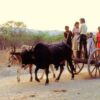
The quality of housing in Mexico has improved significantly in the past two decades. By the 2010 census, 97.8% of Mexican households had access to electricity, compared to 95.0% in 2000 and 87.5% in 1990. That this figure is approaching 100% is a real accomplishment given that many Mexicans live in very isolated mountainous communities. […]
More Mexican women entering the workforce and becoming heads of households
The proportion of women in the workforce is increasing each year. By 2010 a full one-third (33.3%) of women were working compared to 29.9% in 2000. According to 2010 census data, the rate of economic participation of women is very closely linked to community size. In urban areas of over 100,000 population over 41% of […]
Literacy levels in Mexico among those over age 15 have increased rather steadily for more than a century, reaching 93.1% in 2010. The Federal District had the highest literacy level, 97.9%, while the lowest levels were in Chiapas, 82.2%; Guerrero, 83.3% and Oaxaca, 83.7%. The gap between the Federal District and Chiapas is quite large […]
Attempts to provide drainage for Mexico City date back to Aztec times
An old joke relates how engineers initially rejoiced at successfully draining the former lake on which Mexico City was built (something the Aztecs had tried, but failed to achieve), only to discover that the city now lacked any reliable source of fresh water for its inhabitants (something the Aztecs had successfully managed by building a […]
Which Mexican states attract most migrants?
Mexico-USA international migration remains a hot topic in any “Geography of Mexico” program. But international migration is not the only form of migration in Mexico; internal (domestic) migration is also important. This includes people moving house within the same town or city, as well as those who move to a different town, city or state. […]
Mexico introduces a carbon tracking system to monitor its greenhouse gas emissions
A recent Scientific American article (15 March 2011) examines Mexico’s newly introduced system to track greenhouse gas emissions. The article, by Saqib Rahim, originally appeared in ClimateWire. Systems to monitor emissions are essential if countries are to know whether or not they are meeting emissions targets. Mexico’s 2012 goal is to cut its greenhouse gas […]
2010 Census data show a significant improvement in Mexican education
Mexicans over age 15 are now getting 8.6 years of schooling on average, compared to only 7.5 years in 2000 and 6.5 years in 1990. The increase of over a year in the past decade is impressive. While males are still getting more education than females, the gap is closing. Males got 8.8 years of […]
The cultivation of chiles in Mexico
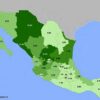
In a previous post, we saw how chiles (Capsicum spp.) have been cultivated in Mexico for centuries (the oldest record of domestication dates back to 4100BC) and they made an important contribution to Mexico’s traditional cuisine being recognized by UNESCO as an “Intangible Cultural Heritage of Humanity.”In this post we take a closer look at […]
Why Mexico plays an important part in one firm’s vertical integration of the citrus fruit industry
In an earlier post, we looked at the geography behind the cultivation of oranges in Mexico. In this follow-up, we report on an example of vertical integration in the citrus industry. Vertical integration occurs when the same firm controls several successive stages of the production of an item. In this case, the same firm that […]
Foreigners are defined as individuals born in another country, but residing in Mexico. According to the recent census, almost a million (961,121) foreigners were living in Mexico in mid-2010. In 2000 there were only about half as many (492,617). Among foreigners, there were slightly more males than females (50.6% versus 49.4%). Under this definition, children […]
Atlantic and eastern Pacific hurricane names for 2011
Hurricanes are also known as typhoons or tropical cyclones. The table shows the World Meteorological Organization’s official list of 2011 hurricane names. Note that male and female names alternate. Names are often reused in future years, with the exception of the names of any particularly violent storms, which are officially “retired” from the list for […]
Are women better than men at gathering mushrooms on the slopes of a Mexican volcano?
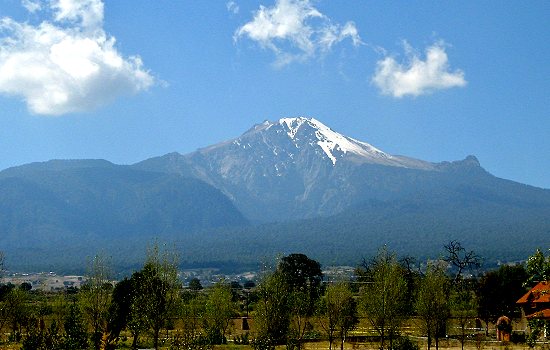
This post summarizes the findings of an article entitled “Sex differences in mushroom gathering: men expend more energy to obtain equivalent benefits”, published in the July 2010 issue of Evolution & Human Behavior. Men are often thought to have superior spatial abilities to women. However, recent research has suggested that such differences are task dependent. […]
How do El Niño events affect Mexico?
La Niña and El Niño are two major periodic disturbances to the normal oceanic and atmospheric circulation patterns over the Pacific Ocean which have widespread effects around the world. The normal circulation in the equatorial Pacific (the Walker circulation cell) results from a low pressure area over the western Pacific (due to warm surface ocean […]
Chiles, one of Mexico’s heritage crops

Chiles (Capsicum spp.) have been cultivated in Mexico for centuries and are a vital ingredient in Mexico’s traditional cuisine, recently recognized by UNESCO as an “Intangible Cultural Heritage of Humanity.” Spicy chiles also have numerous medicinal uses. Graphical representations of chiles have even been used as a national symbol. Chiles are native to Mexico and […]
Micro-businesses help improve the economic and social outlook for irregular settlements
In previous posts about Mexico City’s low-cost and “irregular” housing areas, we have seen how the residents of Ciudad Nezahualcóyotl (Nezahualcoyotl, an irregular settlement which grew into a monster) have gradually transformed their urban environment, and are now regarded by some as part of Mexico’s growing middle class (Are the residents of Ciudad Nezahualcóyotl becoming […]
Review of “Climate and Society in Colonial Mexico: A Study in Vulnerability” (Georgina Endfield)

Environmental historian Georgina Endfield has analyzed a wide variety of colonial archives to explore the complex relationships between climate and social and economic systems. Her book—Climate and Society in Colonial Mexico: A Study in Vulnerability—considers case studies in three distinct zones of Mexico: the arid Conchos Basin of Chihuahua the fertile Oaxaca Valley the agricultural […]
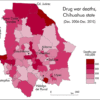
The map (below) of drug war death rates for the 67 municipalities of Chihuahua reveals a rather complicated pattern that is not amenable to easy explanation. There is a clear cluster of very high death rate municipalities around Ciudad Juárez, which has for years been the main focus of drug violence in Mexico. Drug war […]
The book is impressive; indeed, I would say it is encyclopedic, both in terms of Mexico as a place, and geography as a subject. Exactly as promised on p.2, it introduces models and theories that are characteristic of the subject, and then shows how they could be adapted to be made more relevant to Mexico. […]
Rising Chinese labor costs: good news for Mexico
As labor costs in China rise, so more companies located there pull up stakes and move to Mexico, according to Spanish-language press reports. In 2002, wages were estimated to be 240% higher in Mexico than in China; the difference now is just 14%, and this is balanced by the savings in transport costs resulting from […]